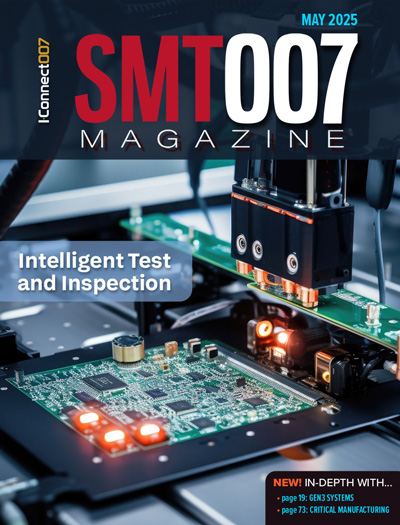-

- News
- Books
Featured Books
- smt007 Magazine
Latest Issues
Current Issue
What's Your Sweet Spot?
Are you in a niche that’s growing or shrinking? Is it time to reassess and refocus? We spotlight companies thriving by redefining or reinforcing their niche. What are their insights?

Moving Forward With Confidence
In this issue, we focus on sales and quoting, workforce training, new IPC leadership in the U.S. and Canada, the effects of tariffs, CFX standards, and much more—all designed to provide perspective as you move through the cloud bank of today's shifting economic market.

Intelligent Test and Inspection
Are you ready to explore the cutting-edge advancements shaping the electronics manufacturing industry? The May 2025 issue of SMT007 Magazine is packed with insights, innovations, and expert perspectives that you won’t want to miss.
- Articles
- Columns
- Links
- Media kit
||| MENU - smt007 Magazine
Thermal Profiling: Sensitive Component Degradation
December 31, 1969 |Estimated reading time: 7 minutes
By Paul Austen, ECD
Solder joints that pass inspection can hide functional degradation of temperature-sensitive devices during the soldering process. From circuit design on, users must account for the thermal sensitivity of passive devices as well as active ones. When factored into the design, and thermal behavior characterized in the NPI phases of the project, the effort is simplified in manufacturing to verification that the thermal profile is met.
Field failure has had many scapegoats over the years solder, the solder joint, the production environment, ESD, cleaning, etc. During the last year, however, we began hearing about failures in boards that had passed test and visual inspection with no indications of a problem. IBM was already speaking to this problem1 and, along with others, led the charge resulting in IPC's J-STD-075. Released by the IPC in December 2008, this standard, "Classification of Non-IC Electronic Components for Assembly Processes," calls for a classification of process-sensitive components as to their thermal sensitivity and recommends a marking system to help contract manufacturers recognize their temperature limits.2
Temperature, Time, and LifespanThe first thing determined when studying these failures was that shiny and strong solder joints seen at inspection belied the degradation of passive components; those components were ultimately responsible for the failure of the product. The question is, why?
When RoHS implementation arrived, peak reflow temperatures of 210° to 225°C for leaded solder gave way to lead-free peaks of 230°250°C and the whole reflow cycle (ramp, soak, peak, time above liquidus, and cool down) adjusted to new times in each oven zone. This was not seen as a roadblock for passive devices. The focus was more on the complex active devices such as BGA, SoC, PoP, and 3D components that incorporate layer upon layer of functionality. They were the items to protect from the soldering process because they tended to be costly. Anticipating this, and perhaps even the subjection to more than one reflow process, such active devices were often designed to withstand the higher temperatures.
Thermal protection barriers were often placed around these components during reflow or wave soldering. If none of that worked, the degraded part was "caught" during in-circuit test (ICT) or X-ray/AOI inspection. This was generally deemed adequate.
Passive components, however, did not trigger the same concern. They should have, but it was not yet evident that many passives were already being subjected to their outermost thermal limits. The stress to thermally sensitive passive components such as capacitors, fuses, etc, increased with temperature; traditional visual cues or electrical measurements did not pick up this collateral damage, which often appeared six months to two years later, after the product was in the hands of the customer.
Unfortunately for OEMs, that was not accounted for in the writing of product warranties, and discovery of the problem has been a costly lesson for them. Components costing less than ten cents were bringing down assembled boards that could cost thousands.
Which Components Fail?Passive components are so varied in material composition and size that no single solution exists. Passive components that could be at risk as process-sensitive in J-STD-075 (as of this writing) include capacitors (aluminum; polymer aluminum; film; molded tantalum), crystals for oscillators and resonators, fuses, inductors and transformers with wire coils, non-solid-state relays, LEDs, and connectors.
To complicate matters, some subcategories within capacitors, for example, are more sensitive than others. Depending on both size and material, there can be significant thermal tolerance differences, sometimes as much as 20°C. Different materials exhibit different tolerances at different stages of the reflow process. A ceramic capacitor, for example, will be more sensitive to the ramp rate because of its ability to distribute heat quickly and evenly. Others may not show stress until they reach peak temperature or time above liquidus (TAL).
Degradation takes many forms (Figure 1). It can, depending on the component, manifest as swelling, shrinking, damage to seals, structural damage, or actual melting of the housing, loosening of connector contacts, and more. If the components are only slightly overheated during reflow and not severely degraded, failure may occur further out in field time as heat generated from product usage pushes the already stressed component until it either swells, melts, or in the case of a fuse, opens prematurely.
The third element of these field failures is that the product's lifespan influenced both the occurrence and the reporting of failures. High-turnover/short-lifespan products such as cell phones were often traded in or retired before failure occurred. It does not mean that failure would not have occurred had they been in use for longer periods of time.
Items that were designed to last for longer periods, from two to eight, ten years, even some longer, usually exhibited failures within six months to two years. If this were a backplane or a motherboard used in medical or aviation, consequences could be not just the cost of return and rework, but human life as well, with catastrophic liability for the OEM.
Reducing Failures: Using Thermal ProfilingWhat is the next step? J-STD-075 will help by identifying sensitive components and calling component manufacturers to mark that classification on the reel or other delivery container. This is not enough.
OEMs and volume manufacturers (CMs and EMS providers) should regard thermal profiling not as a single step, but as an ongoing process to help prevent early failure of all sensitive components, active or passive. All parts have temperature limits, and until we profile the process to which they are subjected, we cannot know if we will cause harm. Profiles must also be run on passive components to obtain an oven recipe that enables them to survive the soldering process intact and functional. The reasons to profile now go beyond good solder joints.
Establishing Dialogue to Ensure the ProcessOEMs and volume manufacturers must have a dialogue regarding the soldering process and its effects on components. Currently, this is sporadic and under-valued. While some information is in parts data sheets and may have been noted during design, it doesn't always make it to the volume manufacturer. OEMs often say, make it lead-free, leaving the details to their manufacturers, who often say they are not told of thermal issues. Many just don't ask. The OEM designer can no longer assume that it is the sole responsibility of the volume manufacturer to deal with thermally sensitive components. Purposeful design and component selection become paramount. The volume manufacturer, conversely, can no longer assume the OEM designer has populated the board with components that are proven to take the heat.
To achieve a predictable dialogue between OEM and volume manufacturer for each job, consider first the factors. Manufacturing management that has "seen it all" and can specify verification processes and protocols are few and far between. If CMs are in a different country, with a different language, communication problems escalate. A standard dialogue assumes increased importance and can help break the language barrier.
For thermal quality management, OEMs and assemblers must share guidelines and check lists that foster such a dialogue. Using separate stages for component thermal requirements, machine recipe development, and thermal profile verification, will let both parties see the issues involved and the necessary steps for developing a mutually beneficial program of thermal quality management.
Generally, assemblers must advance the process that characterizes the maximum temperatures of all components, whether passive or active, clearly identifying those specified as sensitive in the J-STD-075 standard, or others known to be sensitive. Marking according to J-STD-075 will prove valuable here. Characterization must also account for the solder specs, whether alloy or paste/flux, and insist on a thermal profile that proves that an oven recipe was developed to meet the required thermal profile for all components.
AssemblyGood thermal quality management must verify that the oven maintains that recipe during future production, since varying events (room conditions, flux buildup on fans, recipe changes between runs, etc.) can affect oven operation. This is one reason that thermal profiling is an ongoing process rather than a single step.
A thermal profile is run to ascertain the profile is in spec. Software indicates if sensitive components are in danger. If so, this allows recommendation to the OEM, whether it be protecting the component using a reflow solder fixture, attaching the component at post-reflow hand soldering, or designing out the component in question. Obviously, an acceptable profile is more desirable than the other options, especially since hand soldering introduces the variable of individual skill and consistency. However, these other options may be necessary.
ConclusionNow that industry evidence and J-STD-075 address the issue of sensitive passive components, we must change the way we do business. Both active and passive components must be included in the thermal profiling process, and profiling must start early in the NPI process so that design for manufacturability (DfM) is meaningful. Sensitive components must be considered in the profile at every stage. Starting this inclusive thermal profiling at the beginning of NPI helps ensure success at the end. Communication between the OEM and manufacturer/s must occur to identify those components potentially at risk from the manufacturing process. Skipping it is an invitation to early field failure.
REFERENCES: 1. "Process Development with Temperature Sensitive Components in Server Applications," L. G. Pymento, W.T. Davis, Matthew Kelly, Marie Cole, Jim Wilcox, Paul Krystek, and Curtis Grosskopf; IBM Corporation, multiple locations, 2008.2. "J-STD-075, Classification of Non-IC Electronic Components for Assembly Processes," IPC, December 2008.
Paul Austen, senior project engineer, ECD, holds a degree in electrical engineering from Portland University and is a thirty-year industry veteran. Contact him at paul.austen@ecd.com.


